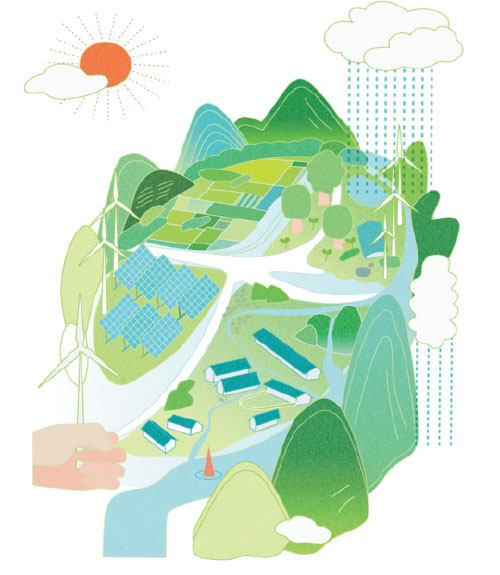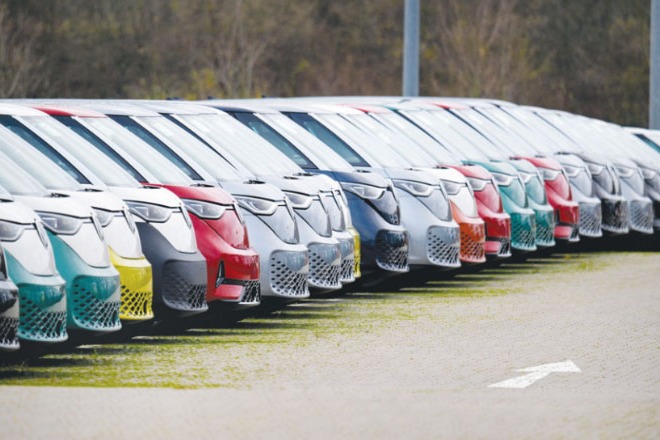Power switch


China and Middle East countries are exploring new mechanisms for energy transition cooperation
Editor's note: The world has undergone many changes and shocks in recent years. Enhanced dialogue between scholars from China and overseas is needed to build mutual understanding on many problems the world faces. For this purpose, the China Watch Institute of China Daily and the National Institute for Global Strategy, Chinese Academy of Social Sciences, jointly present this special column: The Global Strategy Dialogue, in which experts from China and abroad will offer insightful views, analysis and fresh perspectives on long-term strategic issues of global importance.
Middle East countries are going through a major transformation of their energy structure, an essential path to achieve economic diversification and sustainable development. The energy transition in the Middle East not only impacts regional political, economic and social development, but also influences the global climate change response and sustainability as major powers and Middle East countries are competing for energy dominance in the transformation of the global energy system.
An International Energy Agency report indicates that based on the energy transition plans announced by Middle East countries, by 2030, the region's total renewable energy (excluding hydropower) generation capacity will exceed 192 gigawatts, 17 times the current level, of which solar power will account for more than 42 percent and wind power will account for about 35 percent. The rapid development of renewable and clean energy not only advances the region's energy transition and carbon emissions reduction, but also lays a strong foundation for its sustainable development.
Presently, China has built renewable and clean energy projects as part of the power grid of the Gulf states and the North African Power Corridor, and forged important partnerships with countries such as Saudi Arabia, the UAE, Algeria and Morocco, helping to shape an energy security community. Energy cooperation between China and Middle East countries has evolved from general trade to more in-depth models such as technology collaboration and two-way investments. Although the cost of renewable energy generation in the Middle East continues to decline, China and Middle East countries still face many challenges in energy transition collaboration.
First of all, Middle East countries' awareness of the urgency of energy transformation and energy subsidy system hinder the process of energy system transformation cooperation. Economies in most countries in the region are tied to oil and gas revenues. Therefore, they have established social welfare schemes including oil, natural gas and electricity subsidies, which drive down energy prices.
It is hard for renewable energy projects to directly access government subsidies. Due to the lack of competitive pricing, non-hydro renewable energy collaboration between China and Middle East countries has been progressing slowly.
Second, new energy adoption in the Middle East remains relatively low and the demand for new energy technologies needs to be stimulated. Only 1 percent of the region's electricity is sourced from wind and solar energy, with slightly higher percentages in countries such as Jordan (9 percent), Yemen (5 percent), Israel (3 percent), and the UAE (3 percent). In some countries, the share of wind and solar power in their total energy mix is significantly lower, such as Iraq with only 0.1 percent, Saudi Arabia 0.2 percent and Iran 0.4 percent.
Third, Middle East countries rely heavily on Western-imported equipment and components in their limited demand for energy transition technologies, especially for solar and wind energy, power storage and hydrogen energy. Chinese companies and technologies are struggling to gain sizable access to the Middle East market.
Fourth, digitalization has become a new challenge. Given the unique context of the energy transition in the Middle East, the digitalization of the traditional oil and gas sector is critical, with digital value creation, data integration and platform building as essential trends. In practice, as the Middle East energy industry grows more digitized, connected and smart, China and Middle East countries must compete with globally renowned oil and gas companies in the digital realm.
Guided by the global target of net-zero emissions by 2050, China and many Middle East countries have proposed carbon neutrality timetables and road maps. At the 75th United Nations General Assembly, China pledged to peak its carbon emissions before 2030 and achieve carbon neutrality before 2060. Later at the first China-Arab States Cooperation Forum, China identified joint actions on energy security as one of the eight major common actions for China-Arab cooperation, opening up vast prospects for energy transition cooperation between the two sides.
As part of the joint energy security actions, China is willing to work with the Arab states to build a Sino-Arab Clean Energy Cooperation Center, support Chinese energy companies and financial institutions to participate in renewable energy projects with a total installed capacity of more than 5 million kilowatts in the Arab states.
The United Arab Emirates, the first country in the Middle East to release a carbon neutrality timetable, has pledged to reduce carbon emissions by 23.5 percent by 2030.Additionally, Bahrain, Israel, Oman, Jordan, Saudi Arabia, Turkiye, and Morocco have also committed to emissions reduction targets and timelines.
In the traditional energy sector, China and Middle East countries are upgrading cooperation models to cover the entire industry chain of the oil and natural gas sectors. Flagship projects include the Abu Dhabi onshore oil exploration blocks and the Yanbu Aramco Sinopec Refining Company.
To achieve net-zero emissions, China and Middle East countries are exploring new mechanisms for energy transition cooperation. The focus of the cooperation has shifted from general trade to a model emphasizing both investment and energy infrastructure construction, creating a market for investments in clean energy digitalization and grid construction.
The Middle East is among the regions with the poorest performance in terms of renewable energy increments. In 2019, the increment of renewable energy in the Middle East accounted for only 26 percent of the region's total power generation capacity increment. Elsewhere, increments in renewable energy capacity were nearly three times higher. Therefore, the energy transition in the Middle East holds immense potential and is poised for rapid development in solar and wind power. Renewable energy technologies are expected to be widely promoted and applied in the region.
In recent years, China has emerged as a global leader in wind and photovoltaic power with cutting-edge technology and an extensive transmission network. As an integral part of the energy transition efforts of many Middle East countries, China will contribute to the development and utilization of renewable energy in the entire Middle East region.
The author is a researcher with the Institute of West Asian and African Studies at the Chinese Academy of Social Sciences. The author contributed this article to China Watch, a think tank powered by China Daily.The views do not necessarily reflect those of China Daily.
Contact the editor at editor@chinawatch.cn.

































